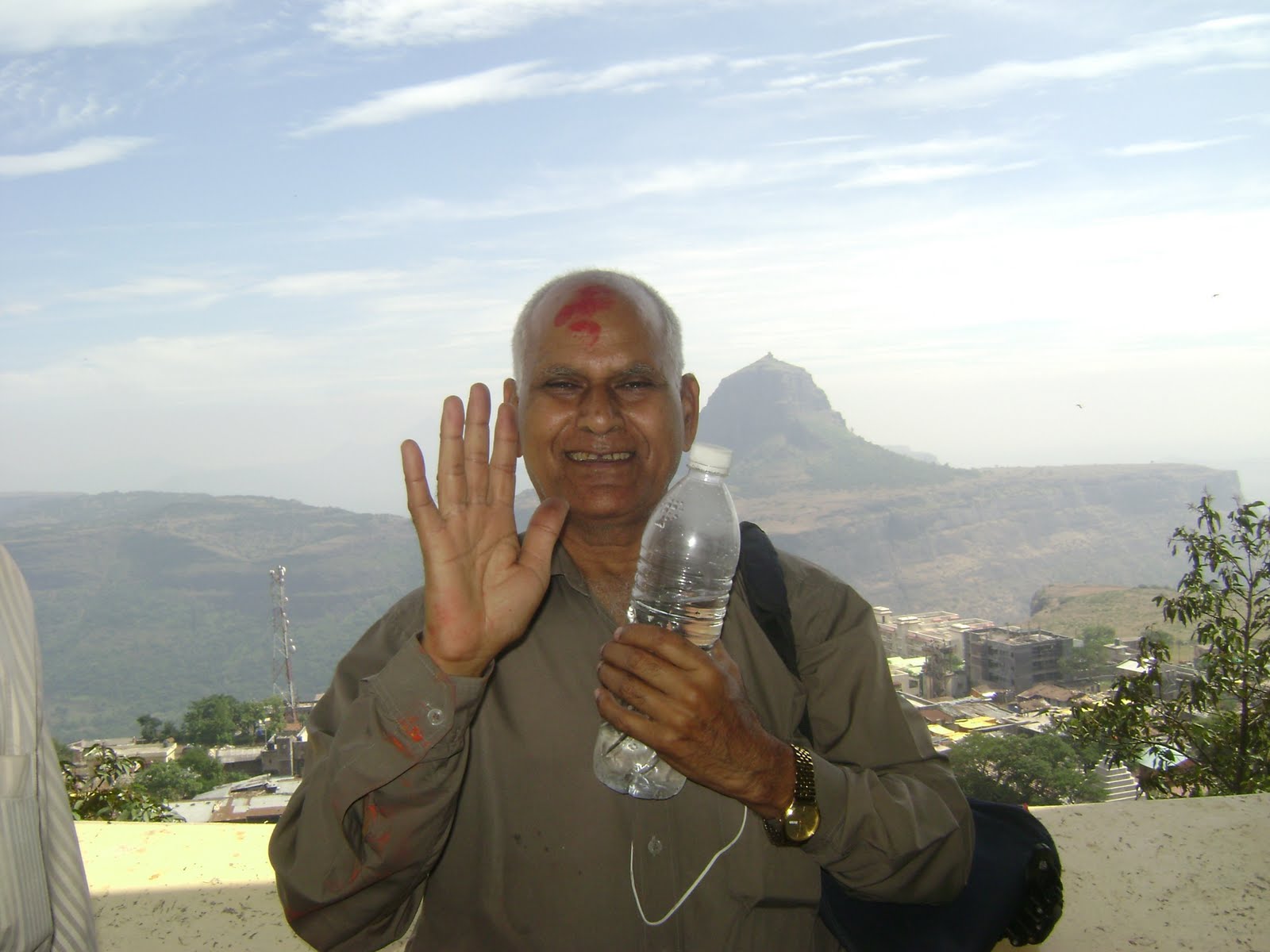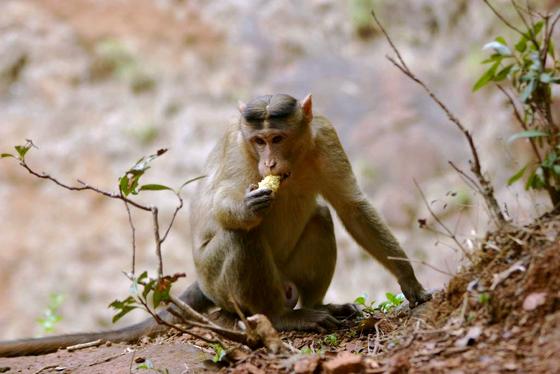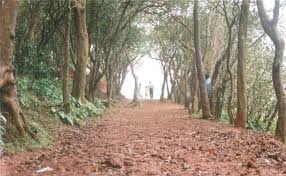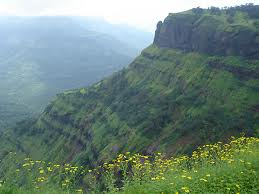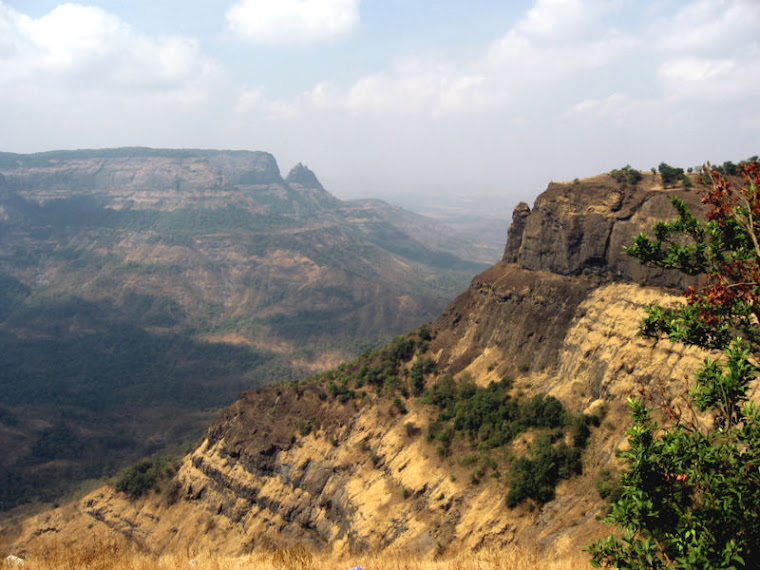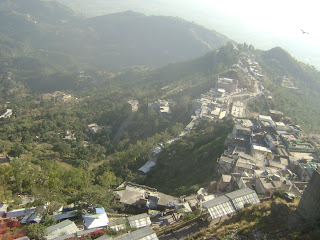

























Sushil Ojha (64) from DehraDun describes the MONKs and MONK(ey)s
at Vipassana Meditation Centre Dhammashikhar(2000Meters) near McLeodGanj in Dharaamshala (Himachal Pradesh) 01 Nov to 12 Nov 2011
After my first 10 days Vipassana residential course at Dhammagiri (Igatpuri) in July 2011, I applied online for my second Vipassana meditation course scheduled to begin from 1st Nov 2011 at Dhammashikhar (Dharamshala) and happily received their email confirming my Regn. No. M 41(Old Student)
Starting from DehraDun on 29th Oct evening by Amritsar Express, I was at Golden Temple next morning till noon and then by evening at Pathankot on 30th Oct. Here, I learnt that the Narrrow Guage Kangra Valley Toy Train was not running since last six months due to some impairment enroute, I hurried to go to Chamba by next morning HP bus on 31st Oct and after passing whole day there seeing around tourist place Chamba, I did night travel by 9:30 pm bus from Chamba to Dharamshala via Banikhet and Kangra ( a little longer route) and thus reached Dharamshala early cold morning by 4:15 am on 1st Nov 2011.
From Dharamshala ISBT, I took 7:30 am first local bus to McLeodGanj(10Km) and an autorikshaw on uphill steep road to Dharamkot(2Km) by 8:15 am. Here I entered the gates of Himachal Vipassana Centre Dhammashikhar(2000Meters) to find a few more students like Suresh Sharma(Shimla), Samrat Rana(Saharanpur), Dinesh Roy(Bhubaneshawar), Lekh Raj Matta(Delhi) and me waiting for the office to open only after daily 8 to 9 am group meditation going on meant for non residential local meditators.
At about 9 am, Registration process opens up and in due course, I am allotted Locker bag No M 5 for safe deposit of Mobile, Camera, Cash & Laundry bag No. M 5 for keeping dirty cloths to be given to laundry agency and finally Accommodation Room No. E 3 to be used by me during 10 days Programme.
After lunch at about 11 am, I saw that this Centre is on top of the hill (2200 Meters height, temp 10 degree Celsius) amidst thick forest of very old Deodar trees and with monkeys living there without damaging or disturbing the people or properties. Later I was told that even snakes, scorpions and lizards are also seen occasionally but without doing any harm unless disturbed. These creatures were living there in complete harmony with Vipassana meditators like MONKs, specially with unharmful MONK(ey)s
At about 12 noon, had hot water bath and then slept (1 to 4 pm) under two blankets over me and two blankets under me (using my personal sleeping bag too).
In between 4 to 4:45 pm, met new student Bharat Bhushan Sharma(56) resident of Distt Kangra,who was younger real brother of Vipassana Asst Teacher Shri Rohani Kant Sharma(65).
At 5 pm, helped by 4 Dhamma Sewaks, David of Argentina,Thaksi of Japan,Bapi of Kolkata and one from Israel(name not known), we all had hot masala tea, ginger water, herbal tea with or without sugar as per choice and some snacks. By sun set, the cloudy weather indicated rains bringing the temperature to below 10 degree Celcius.
At 7 pm, about 100 students (males and females separately), assembled in the dining hall to listen to the introductory talks by the Course Manager Shri Yogesh Sharma / Asstt Teacher Shri Rohani Kant Sharma. Now theNoble silence (Maun Vrat) strictly to be followed hereafter by all students(meditators / sadhaks)
At 8 pm, along with the Vipassana Asstt teacher (Male) Shri Rohani Kant Sharma and Vipassana Asstt teacher (Female) Smt Kirti Sharma, all students sat (males and females separately) in Dhamma Hall No.1 on their allotted ground cushions/chairs (if needed) for starting meditation as per teachers instructions.
As an old student, I sat cross legged (in Sukhashan) on cushion No.D1 (later on with back support also).
We were total 7 male old students (including 3 foreigners) who also sat on their respective Cushion No.A1 Mr Kochi (43) of Japan, No.B1 Mr Aviktal (40) of Israel, No.C1 Mr S K Kalsi (31) of Mumbai, No.D1 S K Ojha (64) of DehraDun, No.E1 Mr Suresh Sharma (39) of Shimla, No.F1 Mr Jeet Kaushik (40) of Dharamshala, No.G1 Mr Eric Jayal (52) of France.
Similarly, I guess that there were 4 female old students and all were foreigners. Even amongst 46 new female students, the number of foreigners was possibly more than 50%. The female Dhamma Sewikas were all foreigners a few knowing Hindi language also.
Names of some new students including foreigners which I may mention at the end of this description.
Vipassana programme Day 1 starts on 2nd Nov 2011
04 am: Wake up call to get ready after morning ablutions
04:30 to 06:30 am: All students sit on their cushions for 2 hours mediation as per teacher’s instructions.
06:30 to 07:15 am: Simple vegetarian Breakfast with tea, milk (with or without sugar) separately for male and female students guided by the Dhamma Sewaks/Sevikas
08:00 to 09:00 am: One hour group meditation started as per audio taped, step by step instructions given by Vipassana Acharya GuruJi Shri S N Goenka
09:00 to 11:00 am: Old students to remain seated in Hall No.1 to meditate as per GuruJi audio cassette instructions (applicable for entire 10days), while all New students to meditate in their respective residential quarters. Hereafter, the daily instructions as per GuruJi audio cassette which will be meant for New students only. However, all old students to be guided by instructions given to them today only.
11:00 to 12:00 am: Simple vegetarian Lunch with salads and seasonal fruits or home made sweets (self service) guided by the Dhamma Sewaks/Sevikas
12:00 to 12:30 pm: Students to tell to the Asstt Teachers about their ailments, medicines, food and comfortable sitting posture during meditation or change of seat etc if required. I told about my left hip joint operation and diabetes medication. The teacher permitted to sit on cushion with back support and also gave instructions for my food intake even in evening / night as required to avoid low sugar situation
01:00 to 02:00 pm: One hour self meditation in Dhamma Hall No. 1 by all students
02.00 to 03:00 pm: One hour group meditation in Hall No. 1 as per voice tape of GuruJi Shri S N Goenka
03:00 to 05:00 pm: Old students to meditate in Dhamma Hall No. 2 or 3
05:00 pm: Lemon water (hot) for old students and Tea / Milk along with snacks for new students
06:00 to 07:00 pm: One hour group meditation in Hall No. 1 as per voice tape of GuruJi Shri S N Goenka
07.00 to 08:30 pm: Video discourse by Guru Ji Shri S N Goenka summarizing meditation exercise of that Day end clarifying issues coming in the minds of students and How & What to be done on next Day. English version of this video discourse was made available in Hall No. 2 for foreigners to plug in and choose their language through such hearing device fitted in Hall No.2, which translates English in to many foreign languages.
08:30 to 09:00 pm: Half an hour group meditation by all students in Hall No. 1
09:10 to 09:20 pm: Took light food as per teacher’s instructions
09:30 pm: Switched off lights and went to bed while concentrating mind as per GuruJi’s instructions.
Vipassana meditation Day 2 on 3rd Nov 2011
04:30 to 06:30 am: I missed wake up call so hurried for Hall No.1 where all students were sitting on their cushions for 2 hours meditation except my cushion No. D1 which was lying vacant till 05:00 am.
06:30 to 09:00 am: All schedules same as followed yesterday
09:00 to 11:00 am: Short meeting of old students with the Asstt Teacher, one by one for any clarification followed by Self meditation by all students together in Hall No.1
11:00 am: During lunch, I noticed two foreigner students sitting next to me eating exactly in Indian way, not leaving any food in their plate, cleaning their utensils like all other Indian students in queue, as well.
12 noon: Basking in bright sunlight instead of taking rest in respective residential quarters
01:00 to 09:30 pm: All schedules same as followed yesterday
Vipassana meditation Day 3 on 4th Nov 2011
04:30 am to 09:30 pm: All schedules same as followed yesterday.
During basking after lunch, two new students developed my curiosity to know more about them. One was short bulky (healthy) young man looking aristocratic and the other was middle aged French cut bearded man always almost first to go for heavy food including full plate dinner also.
Vipassana meditation Day 4 (Vipassana Day starts) on 5th Nov 2011
04:30 am to 11:00 am: All schedules same as followed yesterday.
11:00 am: After lunch I saw the Notice board put up out side dinning hall which read as under:
VIPASSANA DAY: TODAY THERE WILL BE NO LUNCH
TIME INTERVIEW UNLESS ESSIENTIAL
Which in fact meant like this: VIPASSANA DAY: TODAY THERE WILL BE NO LUNCH TIME INTERVIEW (with the teacher) UNLESS ESSIENTIAL
11:00 am to 03:00 pm: All schedules same as followed yesterday.
03:00 to 05:00 pm: Vipassana teaching by Guruji Shri S N Goenka audio tape and Adhishthan Vipassana meditation sitting straight continuously in one posture for hours without opening eyes, legs, hands
05:00 to 09:30 pm: All schedules same as followed yesterday
Vipassana meditation Day 5 (Vipassana continued) on 6th Nov 2011
04:30 am to 09:30 pm: All schedules same as followed yesterday.
Now on wards Vipassana meditation daily in Adhisthan sitting in group in Hall No.1 or 2/3 by all students
04:30 to 06:30 am= 2 hours
08:00 to 11:00 am= 3 hours
01:00 to 05:00 pm =4 hours
06:00 to 09:00 pm= 3 hours
Total = 12 hours Vipassana meditation each day
Vipassana meditation Day 6 (Vipassana continued) on 7th Nov 2011
04:30 am to 09:30 pm: All schedules same as followed yesterday
During basking after lunch, saw basking herd of monkeys amidst basking monks ( Sadhaks / students ) undisturbed by each other. I also noticed and later learnt from Anand Head Cook here few specialty foods like Khichadi, Chocolate Sweets(looking likeGulab Jamun), and Herbal tea.
During Vipassana Video Discourse (07:00 to 08:30 pm) today, I understood as to why I am still not getting free flow vibrations throughout my body. It was because that I was craving for this ever since another old student Mr Parveen Aggarwal (now AGM SBI in DehraDun) shared with me that he got vibrations during his first course itself. On my making this confession, my Asstt teacher Shri Sharmaji exerted that I must not crave for it and also must not try to pray for my hip joint pain to go since these are Anicha(impermanent). These cravings or aversions will go sooner or later. I should concentrate on meditation only with complete equanimity. That’s all. He said that the Adhisthan applies for only one hour sitting and that I can change posture for longer sittings. He guided that only my mind alone( not along with the eye balls within closed eyes) should move throughout body parts one by one. I must not exert any force on my closed eyes in order to concentrate deeply on any part of my body.
Vipassana meditation Day 7 (Vipassana continued) on 8th Nov 2011
04:30 am to 09:30 pm: All schedules same as followed yesterday
Today one student who used to change his postures frequently during Vipassana Sadhana yesterday, was to sit with Asstt Teacher at 12 noon
Vipassana meditation Day 8 (Vipassana continued) on 9th Nov 2011
04:30 am to 09:30 pm: All schedules same as followed yesterday
Vipassana meditation Day 9 (Vipassana continued) on 10th Nov 2011
04:30 am to 09:30 pm: All schedules same as followed yesterday
Today (9 to 10 am) GuruJi touched upon further steps after reaching the state of free flow of uniform subtle sensations through the outer body parts. We all should now try to concentrate on piercing / penetrating inside body organs and finally through spinal chord also to be always aware of all sensations there deep inside observing equanimously and objectively only without any cravings or aversions. Thus reaching to the state of Bhanga (dissolution of body). There should be spot checking once a while when mind immediately touches any smaller part of body and gets awareness of sensations immediately.
Vipassana meditation Day 10 (Metta Bhavana Day) on 11th Nov 2011
One important and last part of Vipassana is Mangal Maitri(Metta meditation.)
Metta Bhavana (Mangal maîtri) is outpouring of goodwill, love and compassion for the world. May all be happy (Bhavatu Sabba Mangalam, Sarve Bhavantu Sukhinah),
May I be free, Free from all hatred, ill will, animosity.
May all share my peace, my harmony, my merits.
May I develop love, goodwill, peace, harmony.
04:30 to 10:00 am: All schedules same as followed yesterday. Noble silence (Maun Vrat) ends now after 10 am. All students amongst males and females separately can now talk with each other but without physical contact in their own interest. The students can collect back their valuables from office, clear their laundry bills/ other purchases if any and make donations on their own volley. Donations from Non Vipassi are not accepted, I was informed, when I opted to donate in the name of Dr Akanksha Ojha.
11 am: After lunch, students are free for photo sessions, develop friendship, do Dhamma Sewa in cleaning the kitchen or premises etc but can not go outside the restricted area of this Vipassana centre until tomorrow 7am.
05 pm: During tea time I talked with earlier mentioned new young student to satisfy my curiosity as to what made him to join so difficult meditation programme here. This Delhi business man(31) shared that he happened to join here by chance and not by choice. On the registration day itself he even took his form and decided to go back seeing the code of discipline here and simple vegetarian meager food that too without dinner. But he however made up his mind to join the course for one or two days only and thought if not suited, he will create problems so that he is turned out from here. You may call it sheer magical effect of Vipassana Acharya GuruJi S N Goenka that this young man developed interest in such a difficult meditation for all the 10 days and shared that he was greatly benefitted out of it. Finally he had decided that on reaching back to Delhi, he will ensure that his mother also joins such a meditation course in near future. God bless them. May all be happy ( Bhavatu Sabba Mangalam ).
Vipassana meditation Day 11 (Valediction Day) on 12th Nov 2011
04:30 to 06:30 am: Valediction discourse on audio tape by GuruJi Shri S N Goenka as to what and how to do practice of Vipassana meditation in back home situation, should the students decide to continue this.
07.00 am : All students now can go out of this premises as per their programme but can not stay here after 5 pm, unless permitted. As such from now onwards, my further travel to various places in Himachal continued till 17th Nov 2011 when I returned back to DehraDun by late evening on 17th Nov 2011.
Yes now the names of some new students are as per my recollections / reflections for benefit of others
Vikas Gakhad(31) of Delhi, Samrat Rana (33)of Chandigarh, Dipak Roy(56) of Bhubaneswar, Lekh Raj Matta(68) of Delhi, Aditya Pathak(28) of Delhi, Ronak Dhanak(28) of Mumbai, Pratyush Rajvanshi(26) of Delhi, Rishi Sharma(33) of Shimla, Gopi Chand Gupta(42) of Delhi and his wife Kavita Gupta,Ved Pandey (46) of Delhi, Vijay Chandrani(54) of Amdabad, Saurabh Chauhan(52) of Shimla, Swami Aaron(45) of Delhi, Shashank(29) of place not known to me, Shahjad(20) of Mumbai, Swami Krishna Deva(40) of Bhagsu in Dharamshala, Pradip Singh(33) of Karnal, Stanzin Zelon(23) of Leh, Eric Jayat(52) of France, Ignat(25) of Russia, Albert(27) of Lativia, Juyan Cabrera(40) of Venezuela / Miami
Now some experiences/views shared by other students of Vipassana meditation
1.Shared by Vipassana student with Metta Bhavana (Mangal maîtri) outpouring of goodwill, love and compassion for the world for the benefit of all who read it and of course with due thanks
Meditation – or Refined torture? You decide!!
Males and females fully segregated this is a 10 day confinement in a place that forbids you to talk, read or write. You can’t pray chant or count beads. And don’t even mention sex, drinks or cigarettes. Worst of all, you will have to spend 12 hours a day, often without moving for an hour at a stretch, watching the breath or experiencing body sensations.
Refined torture? You could say so.
But how do you explain nearly a million people embracing this seemingly masochistic exercise with gusto, a number that is steadily growing? Or that its list of participants reads like a Who’s Who, spanning the front ranks of film stars, industrialists, achievers and bureaucrats? Top Indian actresses like Shabana Azmi, Mousami Chatterjee, Deepti Naval, former Indian CBI Chief D R Kartikeyan; N Baghul, Chairman Of ICICI; Magsaysay award winning police woman Kiran Bedi; Owner of Zee TV Subhash Chandra; famous Odissi dancer Protima bedi, judges,police commissioners, a list of diehard advocate of the technique is endless. So What is this wonder technique? What makes it so popular?
The program is rigorous to say the least. No participant is allowed to leave until the end of the course. All stimuli in the form of reading, writing and talking are forbidden. After a delicious breakfast early in the morning at 6:30 am and vegetarian lunch at 11 am, there is nothing but tea and fruits at 5 pm. And that‘s the easy part. It is the meditation that is grueling. Continuing virtually non stop, save a few breaks for food and rest, it calls for formidable levels of self control and concentration.
The first three and a half days are spent in Anapana, watching with closed eyes, one’s natural patterns of breathing by concentrating on the triangular space between the upper lip and the nostrils. The free ranging mind, with the universe as its oyster, has to restrict to that tiny wedge of space. For the rest of 6 and a half days the tethered mind is harnessed upon the task of studying the subtle sensations within the body- heat, cold, pain, itching, throbbing etc . On the 10th Day, participants are finally allowed to talk without touching each others in their own interests.
May be oddly enough, the course’s monastic severity is responsible for its popularity.
2. Shared by Vipassana student with Metta Bhavana (Mangal maîtri) outpouring of goodwill, love and compassion for the world for the benefit of all who read it and of course with due thanks
Another student’s observation about the technique
The technique is very simple and very scientific. During this entire process I observed two things very powerful and beneficial. The first step when one observes breathing one easily gets carried away by thoughts. These thoughts are basically suppressed thoughts in one’s sub-conscious mind. I came across even those thoughts about which I had never thought consciously earlier. So, by the rigorous practice of the first step one gets free from all suppressed thoughts. It is really like a deep surgical operation of inner mind. When one is free from all suppressed thoughts, one really feels lighter and fresh.
When one practice the third step very rigorously, it makes one free from all aversions, craving, lust and all negative thoughts. During the first step when I used to get carried away by lustful or revengeful thoughts, after the practice of the third step when I thought about those thoughts again, I had found that later I was free from all those thoughts of lust, aversion etc. Those thoughts had lost their intensity totally. It really brings a person to a very tranquil and blissful state of mind. It raises awareness level. If one really practices the technique properly even after the completion of the course, it may lead to the realization of the super-consciousness. After all this technique taught by Gautama Buddha has produced maximum number of enlightened persons.
My suggestion to everyone is – practice this very simple, effective and wonderful technique without torturing yourself. Practice this technique for one hour in the morning and one hour in the evening every day. Don’t torture yourself by maintaining just one posture. There is no need to sit in the squatting position. You can practice this meditation technique by sitting in a chair also in any comfortable posture. Don’t torture yourself by not reacting to the gross sensations like itching or pain. React to them with equanimity in full awareness.
Vipassana is a really very wonderful technique. It is the greatest gift to the mankind by Lord Buddha.
How this technique works
This technique is totally based on the interaction of the conscious mind with the matter. Whatever the thoughts of lust, anger, desire, emotions etc we have got, they are basically deterministic patterns in the sea web of ions in our nervous system. These thoughts are ripples of disturbances in the ionic equilibrium and these disturbances create their own electromagnetic fields with certain amplitude. Higher the amplitude, higher is the disturbance. While the super-consciousness is a homogenous field with zero amplitude without having any ripple of disturbance. When we make our consciousness move throughout our body, it dissolves and destroys all the disturbing patterns in our ionic equilibrium and neutralizes the electromagnetic field of the disturbances in the ionic equilibrium of nervous system. When the field in our nervous system loses all amplitudes, we come to the tranquil field of mind realizing peace and blissfulness.
His recommendation to all husbands and wives
If you really want to teach a lesson to your spouse (to torture her/him) and at the same time to bring a positive transformation in him/her, make your spouse attend this 10 days Vipassana course. You will get more bliss than your spouse.
Questions & Answers about the Technique of Vipassana Meditation
________________________________________
Why is the course ten days long?
Actually, the ten-day course is the minimum; it provides an essential introduction and foundation to the technique. To develop in the practice is a lifetime job. Experience over generations has shown that if Vipassana is taught in periods of less than ten days, the student does not get a sufficient experiential grasp of the technique. Traditionally, Vipassana was taught in retreats lasting seven weeks. With the dawning of the 20th century, the teachers of this tradition began to experiment with shorter times to suit the quickening pace of life. They tried thirty days, two weeks, ten days, down to seven days--and they found that less than ten days is not enough time for the mind to settle down and work deeply with the mind-body phenomenon.
________________________________________
How many hours a day are for mandatory meditating?
The day begins at 4:00 a.m. with a wakeup bell and continues until 9:00 p.m. There are about 12 hours of meditation throughout the day, interspersed with regular breaks and rest periods. Every evening at 7:00 p.m. there is a videotaped lecture by the Teacher, S.N. Goenka, which provides a context for meditators to understand their experience of the day. This schedule has proved workable and beneficial for hundreds of thousands of people for decades.
________________________________________
What language is used in the course?
The teaching is given through recordings of S.N. Goenka, speaking in English or Hindi, together with a translation into a local language. Tape translations exist in most of the major languages of the world, including English.
If the teachers conducting a course do not speak the local language fluently, interpreters will be there to help.
Language is usually no barrier for someone who wants to join a course.
________________________________________
How much does the course cost?
Each student who attends a Vipassana course is given this gift by a previous student. There is no charge for either the teaching, or for room and board. All Vipassana courses worldwide are run on a strictly voluntary donation basis. At the end of your course, if you have benefited from the experience, you are welcome to donate for the coming course, according to your volition and your means.
________________________________________
How much are teachers paid to conduct courses?
Teachers receive no payment, donations or other material benefit. They are required to have their own private means of support. This rule means that some of them may have less time for teaching, but it protects students from exploitation and it guards against commercialism. In this tradition, teachers give Vipassana purely as a service to others. All they get is the satisfaction of seeing people's happiness at the end of ten days.
________________________________________
I can't sit cross legged. Can I meditate?
Certainly. Cushioned chairs with back support are provided for those unable to sit comfortably on the floor because of age or a physical problem.
________________________________________
I'm on a special diet. Can I bring my own food?
If your doctor has prescribed a special diet, let us know and we will see whether we can provide what you need. If the diet is too specialized or would interfere with meditation, we might have to ask you to wait until you can be more flexible. We're sorry but students are required to choose from the food provided to them, rather than bring food for them. Most people find the choice is ample and they enjoy the simple vegetarian diet.
________________________________________
Can pregnant women attend courses? Are there any special arrangements or instructions for them?
Pregnant women may certainly attend, and many women come specifically during pregnancy to take advantage of the opportunity to work deeply and in silence during this special time. We ask pregnant women to ensure they are confident that their pregnancy is stable before applying. We provide the extra food they need and ask them to work in a relaxed way.
________________________________________
Why is a course conducted in silence?
All students attending the course observe "noble silence" — that is, silence of body, speech and mind. They agree to refrain from communicating with their co-meditators. However, students are free to contact the management about their material needs, and to speak with the instructor. Silence is observed for the first nine full days. On the tenth day, speech is resumed as a way of re-establishing the normal pattern of daily life. Continuity of practice is the secret of success in this course; silence is an essential component in maintaining this continuity.
________________________________________
How to be sure one is capable of doing the meditation?
For a person in reasonable physical and mental health who is genuinely interested and willing to make a sincere effort, meditation (including "noble silence") is not difficult. If you are able to follow the instructions patiently and diligently, you can be sure of tangible results. Though it may appear daunting, the day's schedule is neither too severe nor too relaxed. Moreover, the presence of other students practicing conscientiously in a peaceful and conducive atmosphere lends tremendous support to one's efforts.
________________________________________
Is there anyone who should not participate in a course?
Obviously someone who is physically too weak to follow the schedule will not be able to benefit from a course. The same is true of someone suffering from psychiatric problems, or someone undergoing emotional upheaval. Through a process of questions and answers, we will be able to help you decide clearly beforehand whether you are in a position to benefit fully from a course. In some cases applicants are asked to get approval from their doctor before they can be accepted.
________________________________________
Can Vipassana cure physical or mental diseases?
Many diseases are caused by our inner agitation. If the agitation is removed, the disease may be alleviated or disappear. But learning Vipassana with the aim of curing a disease is a mistake that never works. People who try to do this waste their time because they are focusing on the wrong goal. They may even harm themselves. They will neither understand the meditation properly nor succeed in getting rid of the disease.
________________________________________
How about depression? Does Vipassana cure that?
Again, the purpose of Vipassana is not to cure diseases. Someone who really practices Vipassana learns to be happy and balanced in all circumstances. But a person with a history of severe depression may not be able to apply the technique properly and may not get the desired results. The best thing for such a person is to work with a health professional. Vipassana teachers are meditation experts, not psychotherapists.
________________________________________
Can Vipassana make people mentally unbalanced?
No. Vipassana teaches you to be aware and equanimous, that is, balanced, despite all the ups and downs of life. But if someone comes to a course concealing serious emotional problems, that person may be unable to understand the technique or to apply it properly to achieve the desired results. This is why it is important to let us know your past history so that we can judge whether you will benefit from a course.
________________________________________
Do I have to be a Buddhist to practice Vipassana?
People from many religions and no religion have found the meditation course helpful and beneficial. Vipassana is an art of living, a way of life. While it is the essence of what the Buddha taught, it is not a religion; rather, it is the cultivation of human values leading to a life which is good for one and good for others.
________________________________________
Why to stay for the entire ten days?
Vipassana is taught step by step, with a new step added each day to the end of the course. If you leave early, you do not learn the full teaching and do not give the technique a chance to work for you. Also, by meditating intensively, a course participant initiates a process that reaches fulfillment with the completion of the course. Interrupting the process before completion is not advisable.
________________________________________
Is it dangerous to leave a course early?
The point is that leaving early is shortchanging you. You don't give yourself a chance to learn the full technique and so you won't be able to apply it successfully in daily life. You also interrupt the process in the middle rather than letting it come to the proper conclusion. To get home a day or two early, you waste all the time you have invested.
________________________________________
How about the tenth day, when talking is allowed and serious meditation stops? Can any one leave then?
The tenth day is a very important transition back to ordinary life. No one is permitted to leave on that day.
Sushil Ojha, retired Manager State Bank Of India from DehraDun
May all be happy (Bhavatu Sabba Mangalam, Sarve Bhavantu Sukhinah),
May I be free (liberated), Free from all hatred, ill will, animosity.
May all share my peace, my harmony, my merits.
May I develop love, goodwill, peace, harmony.
________________________________________
